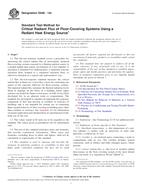Potřebujeme váš souhlas k využití jednotlivých dat, aby se vám mimo jiné mohly ukazovat informace týkající se vašich zájmů. Souhlas udělíte kliknutím na tlačítko „OK“.
ASTM E648-14c
Standard Test Method for Critical Radiant Flux of Floor-Covering Systems Using a Radiant Heat Energy Source (Includes all amendments And changes 9/9/2015).
Automaticky přeložený název:
Standardní zkušební metoda pro kritické zářivý tok podlahových krytin systémy, které využívají sálavé teplo zdroj energie
NORMA vydána dne 1.8.2014
Informace o normě:
Označení normy: ASTM E648-14c
Poznámka: NEPLATNÁ
Datum vydání normy: 1.8.2014
Kód zboží: NS-47525
Počet stran: 16
Přibližná hmotnost: 48 g (0.11 liber)
Země: Americká technická norma
Kategorie: Technické normy ASTM
Anotace textu normy ASTM E648-14c :
Keywords:
critical radiant flux, fire, floor-covering systems, radiant panel, ICS Number Code 97.150 (Non-textile floor coverings)
Doplňující informace
| Significance and Use | ||||||||||
|
5.1 This fire test response standard is designed to provide a basis for estimating one aspect of the fire exposure behavior of a floor-covering system installed in a building corridor. The test environment is intended to simulate conditions that have been observed and defined in full scale corridor experiments. 5.2 The test is intended to be suitable for regulatory statutes, specification acceptance, design purposes, or development and research. 5.3 The fundamental assumption inherent in the test is that critical radiant flux is one measure of the sensitivity to flame spread of floor-covering systems in a building corridor. 5.4 The test is applicable to floor-covering system specimens that follow or simulate accepted installation practice. Tests on the individual elements of a floor system are of limited value and not valid for evaluation of the flooring system. 5.5 In this procedure, the specimens are subjected to one or more specific sets of laboratory test conditions. If different test conditions are substituted or the end-use conditions are changed, it is not always possible by or from this test method to predict changes in the fire-test-response characteristics measured. Therefore, the results are valid only for the fire test exposure conditions described in this procedure. |
||||||||||
| 1. Scope | ||||||||||
|
1.1 This fire-test-response standard covers a procedure for measuring the critical radiant flux of horizontally mounted floor-covering systems exposed to a flaming ignition source in a graded radiant heat energy environment in a test chamber. A specimen is mounted over underlayment, a simulated concrete structural floor, bonded to a simulated structural floor, or otherwise mounted in a typical and representative way. 1.2 This fire-test-response standard measures the critical radiant flux at flame-out. It provides a basis for estimating one aspect of fire exposure behavior for floor-covering systems. The imposed radiant flux simulates the thermal radiation levels likely to impinge on the floors of a building whose upper surfaces are heated by flames or hot gases, or both, from a fully developed fire in an adjacent room or compartment. The standard was developed to simulate an important fire exposure component of fires that develop in corridors or exitways of buildings and is not intended for routine use in estimating flame spread behavior of floor covering in building areas other than corridors or exitways. See Appendix X1 for information on proper application and interpretation of experimental results from use of this test. 1.3 The values stated in SI units are to be regarded as the standard. The values given in parentheses are for information only. 1.4 The text of this standard references notes and footnotes that provide explanatory information. These notes and footnotes, excluding those in tables and figures, shall not be considered as requirements of this standard. 1.5 This standard is used to measure and describe the response of materials, products, or assemblies to heat and flame under controlled conditions but does not by itself incorporate all factors required for fire-hazard or fire-risk assessment of materials, products, or assemblies under actual fire conditions. 1.6 This standard does not purport to address all of the safety concerns, if any, associated with its use. It is the responsibility of the user of this standard to establish appropriate safety and health practices and determine the applicability of regulatory limitations prior to use. Specific hazard statements are given in Section 7. |
||||||||||
| 2. Referenced Documents | ||||||||||
|




 Cookies
Cookies
